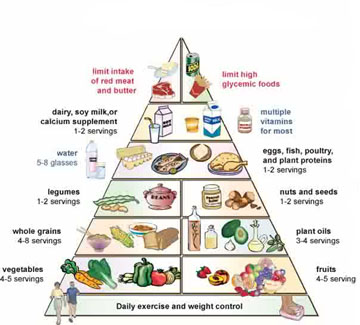Because of new scientific information related to nutrient requirements, the Dietary Guidelines are revised every 5 years to promote health and reduce chronic diseases. The Dietary Guidelines address diet, physical activity, and other issues related to food intake and energy expenditure. They reflect the preponderance of scientific evidence and summarize information regarding individual nutrients and food components into recommendations for eating patterns that can be adopted by the public. Government nutrition programs use the Dietary Guidelines to determine funding for research, nutrition labeling, and to develop nutrition education information for the public. The Dietary Guidelines contain technical information involved in key issues, such as energy balance. They are primarily oriented toward policymakers, nutrition educators, nutritionists, and healthcare providers, rather than the general public. The Dietary Guidelines are translated into a consumer-friendly form through the MyPyramid Food Guidance System to implement the Dietary Guidelines recommendations. The Dietary Guidelines for 2005 include nine focus areas with 23 key recommendations. In general, the message is simple: monitor portion size, be more active, and eat a variety of foods. The guidelines support healthy eating habits to improve health and quality of life. Unique nutrient needs of specific population groups, such as people older than age 50, pregnant women, and children and adolescents, are addressed in Key Recommendations for Specific Population Groups.
Dietary Guidelines for Americans 2005
Focus on fruits
Eat a variety of fruits-whether fresh, frozen, canned, or dried-rather than fruit juice for most of your fruit choices. For a 2,000-calorie diet, you will need 2 cups of fruit each day (for example, 1 small banana, 1 large orange, and ¼ cup of dried apricots or peaches).
Make half your grains whole
Eat at least 3 ounces of whole-grain cereals, breads, crackers, rice, or pasta every day. One ounce is about 1 slice of bread, 1 cup of breakfast cereal, or ½ cup of cooked rice or pasta. Look to see that grains such as wheat, rice, oats, or corn are referred to as “whole” in the list of ingredients.
Vary your veggies
Eat more dark green veggies, such as broccoli, kale, and other dark leafy greens; orange veggies, such as carrots, sweet potatoes, pumpkin, and winter squash; and beans and peas, such as pinto beans, kidney beans, black beans, garbanzo beans, split peas, and lentils.
Go lean with protein
Choose lean meats and poultry. Bake it, broil it, or grill it. And vary your protein choices-with more fish, beans, peas, nuts, and seeds.
Get your calcium-rich foods
Get 3 cups of low-fat or fat-free milk- or an equivalent amount of low-fat yogurt and/or low-fat cheese (1½ ounces of cheese equals 1 cup of milk)-every day. For kids aged 2 to 8, it’s 2 cups of milk. If you don’t or can’t consume milk, choose lactose –free milk products and/or calcium-fortified foods and beverages.

